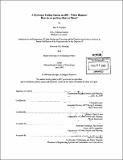| dc.contributor.advisor | Elisabeth Drake and David Laws. | en_US |
| dc.contributor.author | Brydges, Jane E. (Jane Elizabeth), 1973- | en_US |
| dc.contributor.other | Massachusetts Institute of Technology. Technology and Policy Program. | en_US |
| dc.date.accessioned | 2005-09-27T19:45:45Z | |
| dc.date.available | 2005-09-27T19:45:45Z | |
| dc.date.copyright | 2000 | en_US |
| dc.date.issued | 2000 | en_US |
| dc.identifier.uri | http://hdl.handle.net/1721.1/8993 | |
| dc.description | Thesis (M.C.P.)--Massachusetts Institute of Technology, Dept. of Urban Studies and Planning; and, (S.M.)--Massachusetts Institute of Technology, Technology and Policy Program, 2000. | en_US |
| dc.description | Includes bibliographical references (leaves 67-70). | en_US |
| dc.description.abstract | Fuel cell vehicles appear promising for major reductions in local emissions and significant decreases in greenhouse gas emissions from the transportation sector. Efficient fuel cells require hydrogen fuel. If the hydrogen is produced from primary fossil fuel sources, the greenhouse gas benefits are much reduced; full benefits require hydrogen as the onboard fuel - and production of the hydrogen with few or no greenhouse gas emissions. Experience with hydrogen fueling and infrastructure will be important to the long-term success of fuel cell technology. This thesis examines the first steps, barriers and opportunities, and the various strategies to transport hydrogen from the source to the fuel cell. The sources of hydrogen have been thoroughly evaluated, the methods of reforming the source to pure hydrogen are commercially available, and there are several models of fuels cells that are developed to the point where they can be demonstrated in fleet vehicles. What remains to be put in place is an infrastructure to deliver the hydrogen to the fuel cell, an initial system demonstration to build safe operational practices, and a progressive plan to complete the picture of alternate fuel technology to convince the public that this alternative to fossil fuels is technologically practical. In conclusion, this thesis describes an evolutionary plan to transfer bus fleet fuel first to natural gas and then to hydrogen. Initial demonstration will use liquid hydrogen to allow the demonstration of a hydrogen system of fuel for fleet use within five years. Longer term, fueling stations are likely to reform natural gas from the existing pipelines to provide high-pressure hydrogen for wider fueling applications. | en_US |
| dc.description.statementofresponsibility | by Jane E. Brydges. | en_US |
| dc.format.extent | 99 leaves | en_US |
| dc.format.extent | 8759894 bytes | |
| dc.format.extent | 8759652 bytes | |
| dc.format.mimetype | application/pdf | |
| dc.format.mimetype | application/pdf | |
| dc.language.iso | eng | en_US |
| dc.publisher | Massachusetts Institute of Technology | en_US |
| dc.rights | M.I.T. theses are protected by copyright. They may be viewed from this source for any purpose, but reproduction or distribution in any format is prohibited without written permission. See provided URL for inquiries about permission. | en_US |
| dc.rights.uri | http://dspace.mit.edu/handle/1721.1/7582 | |
| dc.subject | Urban Studies and Planning. | en_US |
| dc.subject | Technology and Policy Program. | en_US |
| dc.title | A hydrogen fueling station in 2005?-- will it happen : how do we get from here to there? | en_US |
| dc.type | Thesis | en_US |
| dc.description.degree | S.M. | en_US |
| dc.description.degree | M.C.P. | en_US |
| dc.contributor.department | Massachusetts Institute of Technology. Department of Urban Studies and Planning | |
| dc.contributor.department | Technology and Policy Program | |
| dc.identifier.oclc | 47283539 | en_US |
